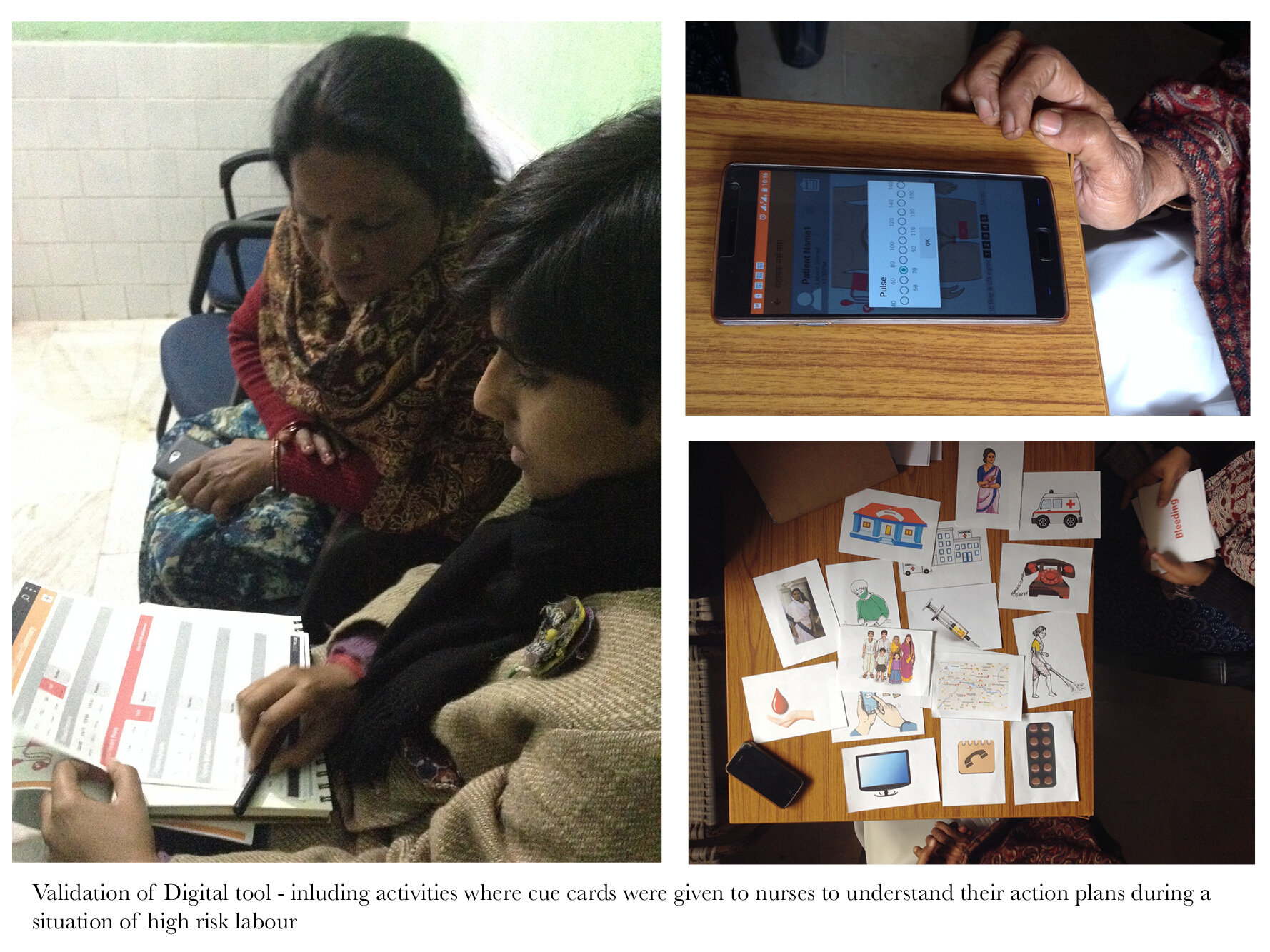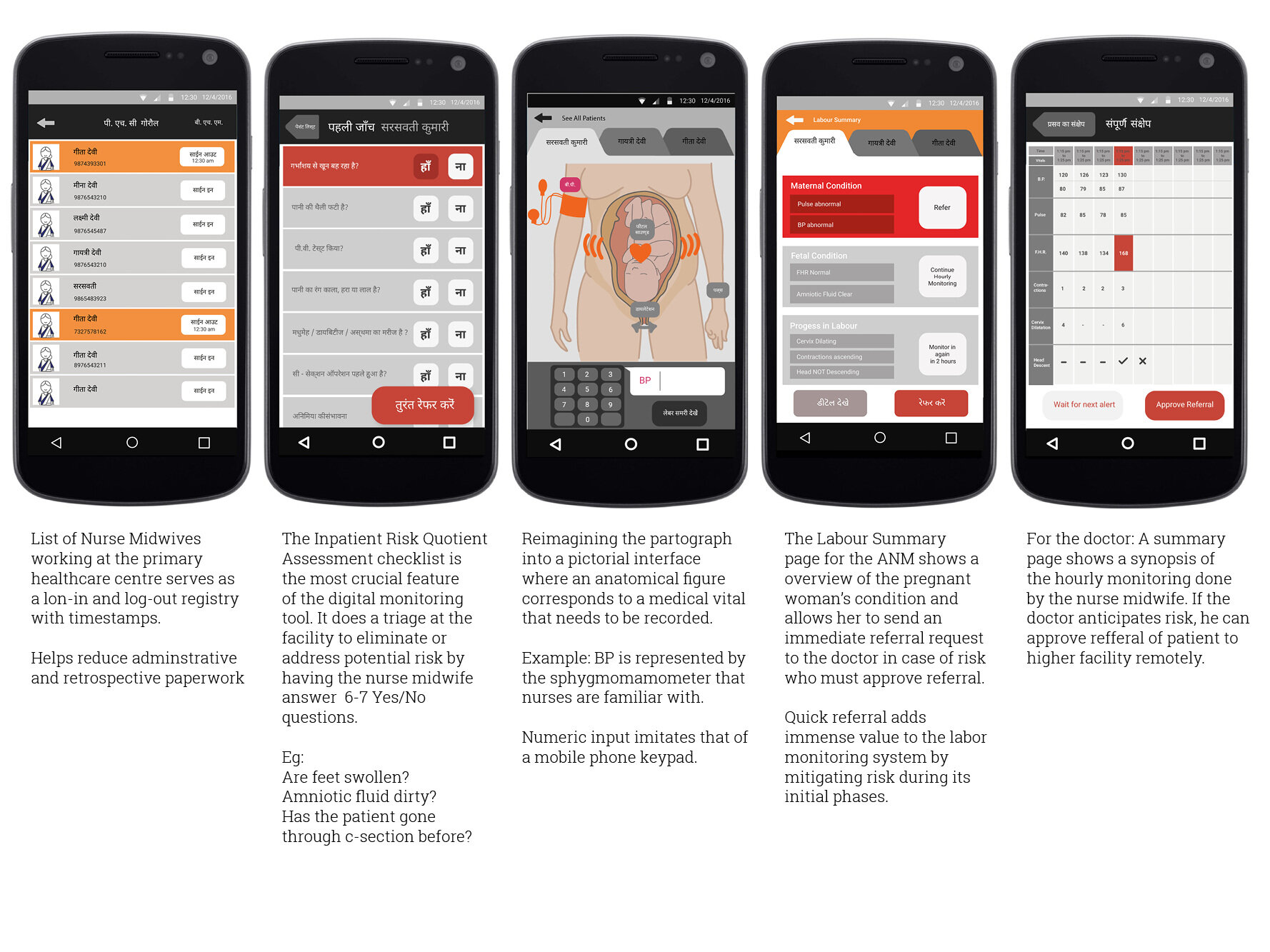A Labor of Resilience
A Gates Foundation grant for Bihar Innovation Lab at Centre for Knowledge Societies, New Delhi, India
Team Sanika Sahasrabuddhe, Kanika Choukse, Divya Dutta (lead), Namrata Mehta, Dinesh Borana
The nurse midwives of Bihar largely cannot comprehend graph and hence are unable to effectively use the partograph. The labour monitoring tool is a reimagination of the WHO partograph (a paper graph tool to track medical vitals during maternal labour) designed for specific local needs of the auxiliary nurse midwives (ANM) in Bihar, India. Two variants were designed : a simplified paper variant and a mobile/tablet digital variant.

Context Summary
With the Government of India implementing schemes that incentivise institutional deliveries, the focus has been to improve the infrastructure of primary healthcare centres and dispense better healthcare services to mitigate the mortality rate among newborns and mothers. Our role included understanding the implication of such policies and schemes in designing effective services that enhance grassroot level healthcare.
Immersing Into The Context
The Auxiliary Nurse Midwife
The Primary User:
The nurse midwife is a key touch point in dispensing public healthcare. Her role includes communicating best practices for reproductive and child health to families. With a skewed nurse to patient ratio, our main aim was to empathize with her - understand her knowledge, experience and trepidations - to equip her with the right tools.
Understanding Touchpoints
System Challenges
With high volume of patients coming to the medical facility, ANMs usually do not have enough time to attend to a patient and fill a partograph. There is evidence to suggest that the partograph may not be the most effective tool to indicate risk or mortality. Bigger issues like systemic gaps, lack of human resource, unavailability of doctors and infrastructure contribute to high rates of mortality of mother and child.
Redesigning the Format
In stages of product development, other than improving fidelity, we ideated how a redesigned partograph would look. Taking the graph format away was our biggest goal. The tool's main aim is to let the nurse communicate hourly progression of vitals to the doctor who isn't available through the 6-24 hours that labour may last.
While redesigning the paper partograph, we reinforced red to be associated with urgency.
Visual Language of Labour Monitoring Tool
Visual elements and format of paper tool were defined and tested. Function was designated to color:
Red- danger | White- safety | Ochre- keep monitoring | Standard input method
Vitals monitored: Cervix Dilation, Fetal Heart rate, contractions, BP, Pulse
The two sided partograph incorporated a risk assessment checklist, demographic data and a redesigned partograph format.
Identifying the Design Gap: In-patient Risk Assessment
A big contributor of high mother and child mortality is the lack of triage and assessment of risk at an early stage during pregancy and at the onset of labour. Keeping the system gap in mind, a protocol was designed - that asks the nurse to check the expectant mother for certain high-risk factors through a yes-no questionaire. If any one of these questions has the answer ‘yes’ the nurse refers the patient immediately. Thus, the redesigned partograph was two-sided with one side being the Risk assesment protocol while the other being the simplified design of the partograph.
The Digital Labor Monitoring Tool
Advantages of Digital Tool over Paper Tool
1. Allows digital sharing of partographs to get quick approvals for referrals.
2. The utilization of this tool will ensure early detection of complications so the ANM can refer the patient in time
3. Increased usage of the labour progression tool that leads to better documentation of a patient’s medical history and better risk management
4. Reminds ANM to fill in vitals at periodic intervals
5. Real-time documentation of health vitalsdata will eliminate retrospective filling.
6. The interface uses an understandable format and may also encourage ANMs to better apply value to the tool.


Designing the Interface and Interactions
Decision-Making Logic [below]
With validation from experts - doctors and nurses, we design a task flow architecture for the digital tool. The task flow was done keeping in mind, the threshold of vitals and when a patient goes into the high risk category and alert is placed at crucial points to nudge the nurse.
Interaction Model to record Cervical Dilation [below]
Cervical Dilation is an important vital to be measured that indicates the onset of labour. The midwives use fingers to measure the dilation of the cervix. They don’t rely on standard metrics like cms. Keeping this in mind, we designed an interaction model where the action can be translated to metric rather than making the user comply with a metric.










